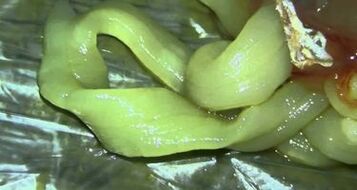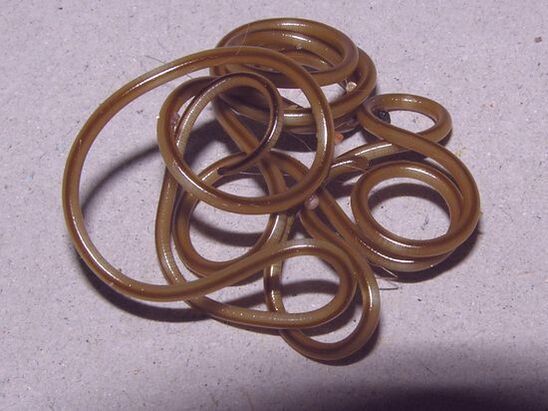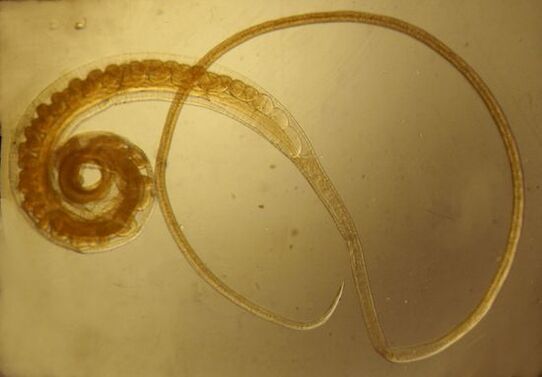
It is healthy to live in the world - the parasites of the body disturb this. These lower plant and animal forms live at the expense of the owner. Translated from Greek, they mean - freeloader.
They can be external and internal through parasitism.
Parasites in the human body are divided into flat and round worms.
The flats, in turn, are divided into trematodes and cystodes.
Roundworms are also called nematodes.
Nematodes in the human body

What parasites live in the body, especially nematodes - long and earthworm-shaped, hence the name - roundworms, these are:
- globular worm;
- pinworms;
- hookworms;
- trichinella.
Roundworm
One of the most common nematodes is a parasite that in some cases reaches a size of 45 cm. The female produces 200, 000 eggs, and this process is independent of whether the male is in the host. Along with the feces, the eggs fall into the ground, where they turn into larvae when favorable factors occur. You can infect this helminth with dirty hands, unwashed vegetables, fruits, berries.
Signs of infection: nausea, salivation, loss of appetite. In the presence of a large number of ascaris, severe consequences can occur, postoperative sutures may rupture, and pancreatitis may occur. Roundworms are especially dangerous for pregnant women - they can penetrate the fetus.
Pinworms
Small worms up to 10 mm in size are mainly infected by children, more often in kindergartens. The sick person becomes the cause of the infection, and if the rules of personal hygiene are not followed, the chance of infection increases significantly. Signs of worms appearing:
- nocturnal itching around the rectum;
- decreased performance;
- sleep disorders;
- nervous disorders.
The presence of pinworms does not endanger the patient’s life, but is quite uncomfortable and causes dysbiosis.
Hookworm
The 20mm parasite is pink, giving less manifestation, but the damage is huge. In the oral cavity, there are teeth and plates with which to chew the blood vessels. The larvae penetrate the body through the skin of barefoot walkers.
The main function of the larvae is to get into the human mouth, from where they descend into the intestines by swallowing saliva, where the adult helminths are excreted. They feed on human blood, which results in anemia. The threat is waste products that poison the body. Signs of the presence of helminths include persistent bronchitis, dermatitis, nausea, abdominal pain, indigestion. The heart suffers from this parasite - myocarditis can appear.
Trichinella
Females of worms reach 4 mm, males are smaller. They die in the external environment and are only viable in the body. The source of infection is raw animal meat. Through the blood vessels, parasites are distributed in all organs, take root and can live peacefully for 20 years.

The most common signs of infection are:
- increased blood counts of eosinophilic leukocytes;
- temperature rise to 40 ° C;
- muscle pain;
- conjunctivitis and swelling of the face.
Trematode parasites
The small helminths have a flat body with 2 suction cups. Most of them are hermaphrodites. Development requires an intermediate host.
Luck
Helminth - hermaphrodite, grows up to 14 mm, affects bile ducts. The oocytes, after entering the water bodies, settle in molluscs, where they develop into larvae, and then the larvae settle on the fish scales. If at this moment a person eats poorly fried fish, he can become infected with this parasite.
In the body of its ultimate master, a human, the fluke enters the duodenum, where the larva grows into an adult helminth. Water bodies are infected by people who consume fish products and work on water vessels (their waste products penetrate the water).
Schistosomes
Helms, heterosexual individuals, resemble needles in appearance. A parasite pair produces up to 3, 000 eggs in 24 hours. A person becomes infected while bathing or with contaminated water. In the lungs and blood vessels, the larva becomes an adult. The egg is then made in the gut.
In the presence of schistosomes, the following can be observed:
- abdominal pain;
- violation of appetite;
- anemia;
- switching from diarrhea to constipation;
- weight loss;
- violation of the cycle in women;
- impotence in men;
- decreased school performance of children.
Once in the nerve fibers, paralysis and damage to the brain are possible.
Where can the helminths settle
People are often interested in where parasites live in the human body?
The localization is due to the type of host that has entered the body of the "parasite. "They settle more often in the digestive system, lungs, heart, liver.
The human body where the parasite lives weakens and begins to suffer from various diseases, so it is not at all difficult to determine whether the parasites live in the body. You just have to be more attentive with yourself, and even if you have the slightest suspicion, you can’t delay your visit to the doctor.

In order for the body in which the 6-letter parasite lives to heal and become healthy, it must follow hygiene rules, do not drink raw water and do not eat poorly cooked meat. Only then can the risk of infection be reduced.
It’s very good to live in this world and you don’t want to think about parasites in the human body, but you have to. After all, every second person on Earth is infected with worms. The organism in which the parasite lives is an area of miracles that will happen. But trust in fate is the multitude of the weak.



























